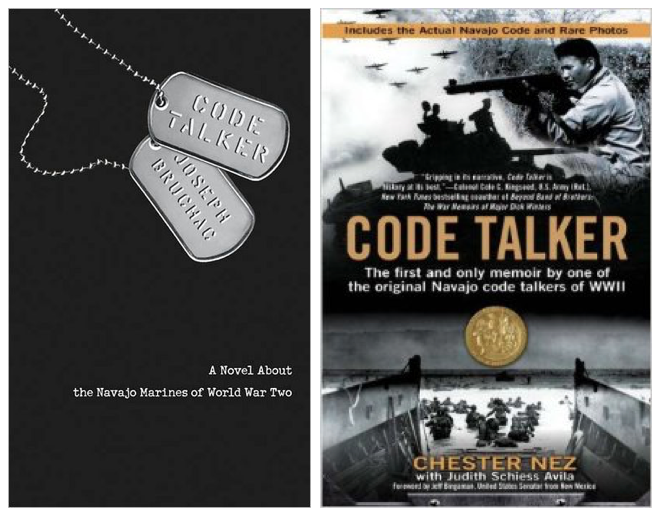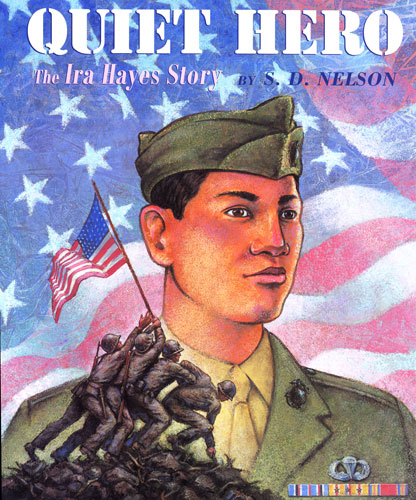By Angeline P. Hoffman, White Mountain Apache Tribe
Worlds of Words’s current exhibit, “Code Making and Perspective Taking,” features stories of Native American code talkers, with art reflections from Tucson High Magnet School art students and fifth graders at Van Buskirk Elementary School. This week, with Veteran’s Day on Friday, November 11, I present a list of children’s and Native American literature that focuses on Native American veterans and their contribution to war efforts.

Time-Life Books’s “The Way of the Warrior,” Alexandria, Virginia, references Native Americans finding honor in the military:
“On December 7, 1941, the superintendent of the Navajo Indian Reservation at Window Rock, Arizona, saw a crowd of armed young men assembling outside his office. When asked why they had come, they answered, ‘We’re going to fight.’ The Navajos’ resolve to join the conflict followed a long tradition of Indians serving the U.S. armed forces. … Joseph Medicine Crow…[w]hile fighting the Germans, …had led a squad across enemy lines, engaged in hand-to-hand combat, and rounded up a band of horses belonging to S.S. officers. When he related these exploits at a ceremony for the recounting of war deed, his elders recognized that he had led a war party, touched an enemy, taken an enemy weapon, and stolen enemy horses. ‘Lo and behold,’ he said later, ‘I had completed the four requirements to become a chief.'” (p. 111)
Over 10,000 Native Americans served in the U.S. military in WWI, and more than 44,000 served in WWII. In WWI, officers in units with Native American soldiers found that these soldiers had “impenetrable native languages. In units such as Oklahoma’s 142d Infantry, with its sizable Choctaw contingent, Indian Code Talkers speaking by telephone easily confounded Germen eavesdroppers who had tapped Allied lines” (p. 117). In WWII, “more than half the eligible residents of some reservations volunteered for military service” (p. 118).
Even after the two world wars, Native Americans enlisted in the military in proportions significantly higher than the U.S. population as a whole. However, “[l]ike other soldiers, Indian veterans have sometimes returned to find the nation seemingly indifferent to their sacrifice. … [Yet,] Max Little, a Seminole who saw combat in Vietnam, [said,] ‘Our veterans are never forgotten'” (p. 118).
This selection of Native American literature and children’s literature covers the topic of Native American veterans. We thank you for being true to the Native American heritage, and we celebrate young, fighting men for gaining maturity and wisdom through war. A Winnebago elder once said, “We honor our veterans for their bravery.”
Title: American Indians in World War I: At War and At Home (WWI)
Author: Thomas A. Britten
This book explores the Native American veterans’ experiences during WWI, both on the battlefield and back home following their contribution to the U.S. wartime efforts. Further, this book details the Native American women’s volunteer contributions.
Title: The Unbreakable Code (Navajo, WWII)
Author: Sarah Hoagland Hunter
Illustrator: Julia Miner
This picture book follows John, a young Navajo boy who is moving to Minnesota with his mother and step-father. He does not want to leave, but his grandfather, a Navajo code talker of WWII, explains to him that the Navajo language will always tie him to his native land.
Title: Code Talker: A Novel about the Navajo Marines of World War Two (Navajo, WWII)
Author: Joseph Bruchac
Code Talker, a fictional novel, introduces the audience to Ned Begay, a Navajo boy who is only 16 years old when he becomes a Navajo code talker in the WWII conflict against Japan. This book honors the Navajo culture and language.
Title: Code Talker: The First and Only Memoir By One of the Original Navajo Code Talkers of WWII (Navajo, WWII)
Author: Chester Nez
Until 1968, the Native American veterans who used code during World War II could not talk about the code — it was classified. This memoir follows 89-year-old Chester Nez’s experiences growing up on the Navajo Reservation and joining the war effort. This book includes the actual Navajo code and rare photos from the war.
Title: Navajo Code Talkers: Secret American Indian Heroes of World War II (Navajo, WWII)
Author: Brynn Baker
In this informational book, fact boxes, infographics, and sidebars aid in explaining how Navajo code talkers in the Marines were able to transmit information in WWII without the Japanese military cracking the code.
Title: Missing in Action (Navajo, WWII)
Author: Dean Hughes
Jay Thacker’s father, who is fighting for the Navy in the Pacific during WWII, is missing in action. When Jay moves to Delta, Utah, with his mom and starts working in the fields, he meets Ken, a worker from the nearby Japanese internment camp. This book is about an unlikely friendship and the power of prejudice and intolerance.

Title: Quiet Hero: The Ira Hayes Story (Pima, WWII)
Author and Illustrator: S. D. Nelson
Ira Hayes, who grew up on the Gila River Indian Reservation in Arizona, joined the Marine Corps during WWII. When he was sent to Iwo Jima, he was part of the famous photograph of four soldiers raising an American flag. The war, this photograph, and the national attention that he received changed Hayes’s life.
Title: World War II and the American Indian (WWII)
Author: Kenneth William Townsend
This informative text, while not a children’s book, gives important background to the Native American experience during WWII. This book is a full account of these experiences from the 1930s to 1945. Included with the history are Native American responses and perspectives that have not been included in other sources.
Title: Year in Nam: A Native American Soldier’s Story (Jicarilla Apache, Vietnam)
Author: Leroy TeCube
Leroy TeCube, who lived on the Jicarilla Apache reservation, left home to serve in the Vietnam War. Year in Nam is TeCube’s story of the war and how his Native American heritage was challenged.
Title: From Warriors to Soldiers: The History of Native American Service in the United States Military
Author: Gary Robinson
From Warriors to Soldiers tells the story of the Native American veterans — what they do and why they do it. To defend their homeland, Native Americans have enlisted in the military in higher numbers, per capita, than other ethnic groups.
Title: Warriors in Uniform: The Legacy of American Indian Heroism
Author: Herman J. Viola
This book, an illustrated history of the Native American legacy of heroism, covers Native American warriors from the 1700s to the present.
Journey through Worlds of Words during our open reading hours: Monday through Friday 9 a.m. to 5 p.m., Saturday 9 a.m. to 1 p.m. Check out our two online journals, WOW Review and WOW Stories, and keep up with WOW’s news and events.
